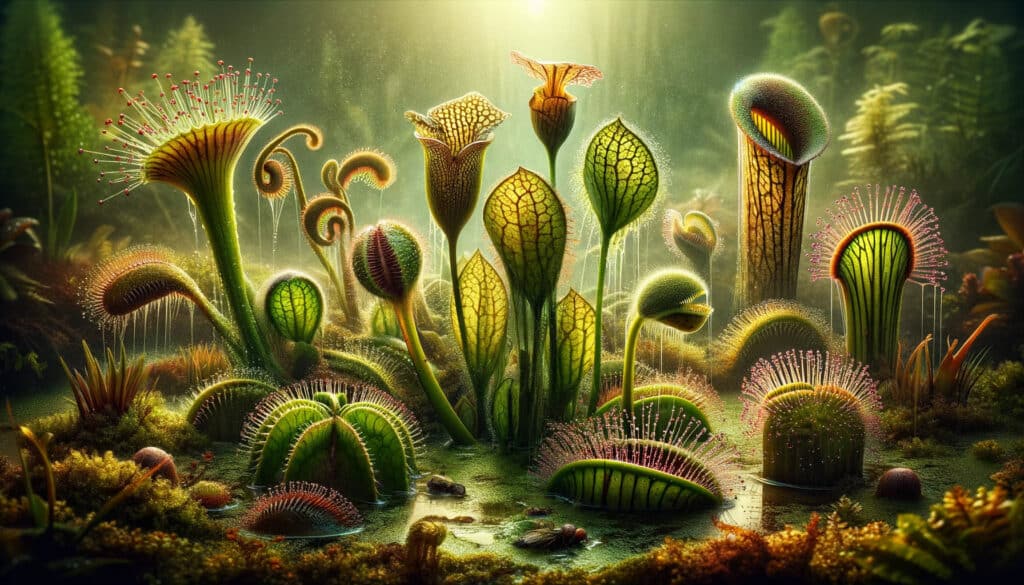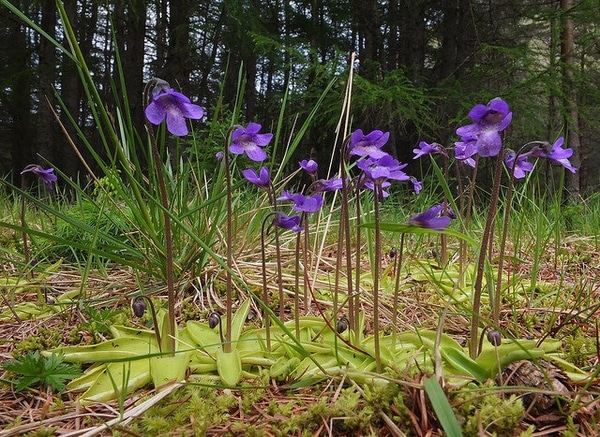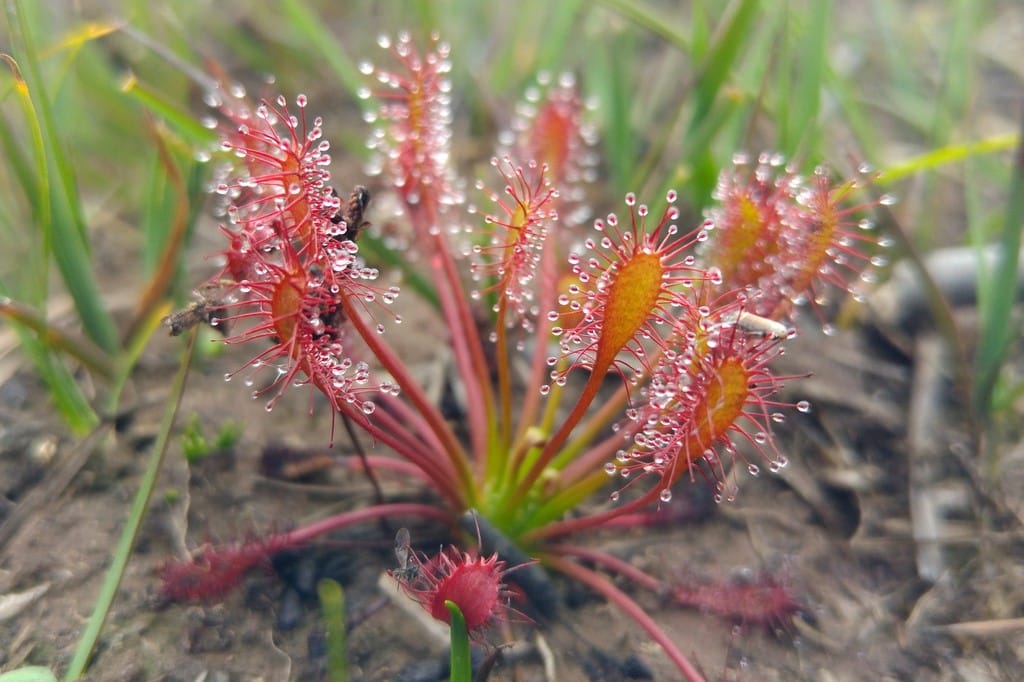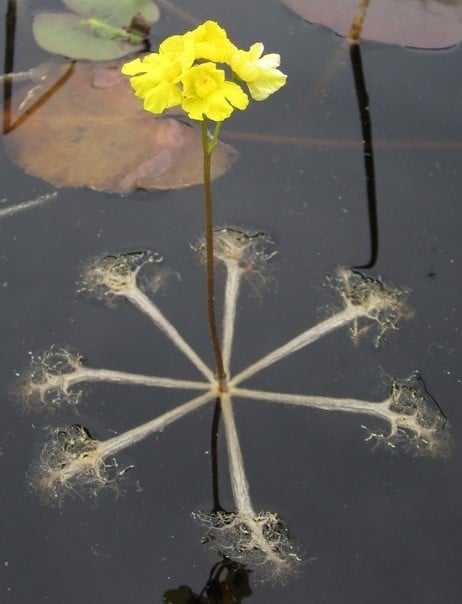
North Carolina is home to many unique species, including 36 species of carnivorous plants. These plants consume small, unsuspecting invertebrates that fall into their traps. Now, you might be wondering, why do these plants eat meat? Don’t they get their food from sunlight through photosynthesis? Well, yes, these plants do photosynthesize, and are able to produce sugars from that process. However, these species live in wet areas with nutrient-deficient soils, thus they have adaptations that allow them to get nutrients from insects, arachnids, and aquatic prey items. There are five groups of carnivorous plants in North Carolina: butterworts, sundews, bladderworts, pitcher plants, and, of course, the Venus flytrap.

Common Butterwort, Pinguicula vulgaris, photo courtesy of Stuart Anthony and the North Carolina Extension Gardener Plant Toolbox
Butterwort species are in the genus Pinguicula, and these plants, found throughout the southeastern United States in very sunny, wet locations, have small leaves with sticky hairs. Often appearing greasy in texture, the leaves form the trap, and insects get stuck in the residue. The struggling of the insect triggers the butterwort to release more of the sticky fluid; once the residue has fully encased the food item, special cells in the leaves will begin releasing digestive enzymes. Believe it or not, this process gets even cooler! Butterworts also release a strong chemical that kills bacteria. This prevents the dead insect from rotting while it is slowly being digested.

A sundew species, photo courtesy of Phil Champion and the North Carolina Extension Gardener Plant Toolbox
Sundews, which are in the genus Drosera, are one of the largest groups of carnivorous plants. In addition to species native to North Carolina, there are sundews found all over the world, found in bogs, fens, and marshes ranging from tropical climates to colder climates. Sundews are similar to butterworts in that their leaves, which are pad-like, are covered in sticky hairs. More struggling results in the fluid stickiness increasing; but instead of fully encasing the insect in a residue, the leaf pads will slowly curl up around the insect before digestion begins. Due to their small size, sundews’ prey items are very tiny, often small gnats and ants.

Swollen Bladderwort, Utricularia inflata, photo courtesy of Robby Deans and the North Carolina Extension Gardener Plant Toolbox
The genus Utricularia contains the bladderworts, and it is the largest genus of carnivorous plants. Aquatic species of bladderworts grow fully submerged, except for the stem and blossom, and they may float freely in the water or attach themselves to a surface. Other bladderwort species that are more tropical are epiphytic, and still other species grow in very wet soil. The bladderworts are unlike any other carnivorous plant in that they have a unique bladder system. These bladders have a trap door covered in tiny hairs. When a prey item touches the hairs, it triggers the trap door to open in a millisecond and the bladder sucks in the prey, closing in about 2.5 milliseconds! So, in about 3.5 milliseconds, the bladderwort has caught its food. How weird and wonderful is that?

Purple Pitcher Plant, Sarracenia purpurea, photo courtesy of David Midgley and the North Carolina Extension Gardener Plant Toolbox
Now pitcher plants, in the genus Sarracenia, are probably some of the more recognizable carnivorous plants in the world. In North Carolina we have the purpurea species, so named because of the color of the flowers and the pitchers themselves. This species is often found in marshes and bogs but is also right at home in wet forest floors and pinelands. The purple pitcher plant’s leaves form pitchers that are open to the sky and collect rainwater. Insects are attracted to little droplets of nectar that are produced along the rim of the pitcher, and as they crawl inward, they encounter tiny hairs that point downwards. This results in a surface that is very easy to climb down, but impossible to climb up! Eventually the insects fall into the pool of water, which also contains digestive enzymes that the plant has produced. What is really cool about the purple pitcher plant is that it is pollinated by a member if the pitcher plant fly genus, Fletcherimyia. The larvae of these flies live in the fluid inside of the pitchers, feeding on some of the insects that have gotten trapped!
The Venus Flytrap, Dionaea muscipula, photo courtesy of Lucy Bradley and the North Carolina Extension Gardener Plant Toolbox
There is only one more carnivorous plant to discuss: North Carolina’s official state carnivorous plant, the Venus flytrap. Venus flytraps, Dionaea muscipula, are mainly found in southeastern North Carolina, though some small populations have been found in northeastern South Carolina. This plant has specialized, folded leaves covered in large and small hairs. When an insect touches those hairs, it triggers the two halves of the leaf to close around the insect, trapping it. Like the butterwort, special cells on the leaves release digestive enzymes, and in about two weeks, the leaf will reopen and be ready to catch another insect. We North Carolinians love Venus flytraps so much that, not only has it been declared the state carnivorous plant, but there is also a house bill to authorize the Venus Flytrap Specialty License Plate! If House Bill 734 passes, some of the proceeds from each license plate renewal will go towards the Friends of Plant Conservation and the North Carolina Botanical Garden Foundation, which will use the money to fund plant conservation education and research.
The Venus flytrap, and many of the other carnivorous plant species, are endangered. Habitat destruction and overharvesting are the two major threats facing these plants today. These species require specific habitat conditions in which to grow and thrive, and if even one of those conditions is thrown off, the plants will start to decline. Gardening and houseplant fever unfortunately results in wild plants of all kinds, not just carnivorous ones, being poached in order to meet the demand. If you have to have a carnivorous plant, purchase one from a reputable nursery. There are many other amazing plants that share the same habitat needs as the meat-eaters, so consider creating a small bog or marsh garden in your backyard. In North Carolina, nurseries such as Carolina Habitats and Plant Delights can be excellent resources for learning how to recreate plant communities in a garden setting. State cooperative extension offices and their Master Gardeners programs would be a good resource for region-specific knowledge. Finally, if you want to see carnivorous plants in action, plan a trip to Carolina Beach State Park, south of Wilmington, North Carolina. These weird and wonderful plants are sure to make a lasting impression.
Special thanks to the North Carolina Extension Gardener Plant Toolbox and all of their amazing photographers for the photographs in this blog and for being a source of great information on the many carnivorous plant species in the state. https://plants.ces.ncsu.edu/



